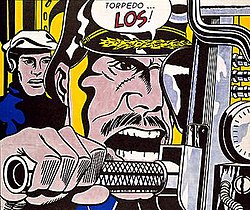
Roy Fox Lichtenstein was an American pop artist. During the 1960s, along with Andy Warhol, Jasper Johns, and James Rosenquist, he became a leading figure in the new art movement. His work defined the premise of pop art through parody. Inspired by the comic strip, Lichtenstein produced precise compositions that documented while they parodied, often in a tongue-in-cheek manner. His work was influenced by popular advertising and the comic book style. His artwork was considered to be "disruptive". He described pop art as "not 'American' painting but actually industrial painting". His paintings were exhibited at the Leo Castelli Gallery in New York City.

Whaam! is a 1963 diptych painting by the American artist Roy Lichtenstein. It is one of the best-known works of pop art, and among Lichtenstein's most important paintings. Whaam! was first exhibited at the Leo Castelli Gallery in New York City in 1963, and purchased by the Tate Gallery, London, in 1966. It has been on permanent display at Tate Modern since 2006.

Girl with Ball is a 1961 painting by Roy Lichtenstein. It is an oil on canvas Pop art work that is now in the collection of the Museum of Modern Art, after being owned for several decades by Philip Johnson. It is one of Lichtenstein's earliest Pop art works and is known for its source, which is a newspaper ad that ran for several decades and which was among Lichtenstein's earliest works sourced from pop culture.

Look Mickey is a 1961 oil on canvas painting by Roy Lichtenstein. Widely regarded as the bridge between his abstract expressionism and pop art works, it is notable for its ironic humor and aesthetic value as well as being the first example of the artist's employment of Ben-Day dots, speech balloons and comic imagery as a source for a painting. The painting was bequeathed to the Washington, D.C., National Gallery of Art upon Lichtenstein's death.
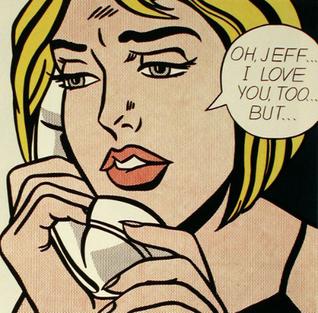
Oh, Jeff...I Love You, Too...But... is a 1964 oil and magna on canvas painting by Roy Lichtenstein. Like many of Lichtenstein's works its title comes from the speech balloon in the painting.
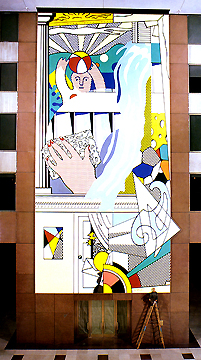
Mural with Blue Brushstroke is a 1986 mural painting by Roy Lichtenstein that is located in the atrium of the Equitable Tower in New York City. The mural was the subject of the book Roy Lichtenstein: Mural With Blue Brushstroke. The mural includes highlights of Lichtenstein's earlier works.
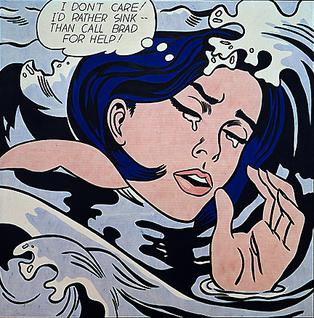
Drowning Girl is a 1963 American painting in oil and synthetic polymer paint on canvas by Roy Lichtenstein, based on original art by Tony Abruzzo. The painting is considered among Lichtenstein's most significant works, perhaps on a par with his acclaimed 1963 diptych Whaam!. One of the most representative paintings of the pop art movement, Drowning Girl was acquired by the Museum of Modern Art in 1971.
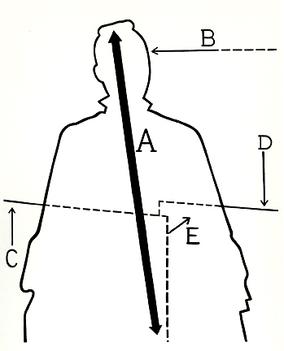
Portrait of Madame Cézanne is a 1962 pop art painting by Roy Lichtenstein. It is a quotation of Erle Loran's diagram of one of Paul Cézanne's 27 portraits of his wife Marie-Hortense Fiquet, now in the Barnes Foundation, Philadelphia. It was one of the works exhibited at Lichtenstein's first solo exhibition in Los Angeles. The work became controversial in that it led to a reconsideration of what constitutes art.

Blam is a 1962 painting by Roy Lichtenstein falling within the pop art idiom. It is one of his military comic book derivatives and was one of the works presented at his first solo exhibition. The work is in the collection at the Yale University Art Gallery

Engagement Ring is a 1961 pop art painting by Roy Lichtenstein. The work is based on the Winnie Winkle series, but Lichtenstein changed both the graphical description and the narrative accompaniment that he presents in a speech balloon. As with most of his early romance comics works, this consisted of "a boy and a girl connected by romantic dialogue and action".

Golf Ball is a 1962 painting by Roy Lichtenstein. It is considered to fall within the art movement known as pop art. It depicts "a single sphere with patterned, variously directional semi-circular grooves." The work is commonly associated with black-and-white Piet Mondrian works. It is one of the works that was presented at Lichtenstein's first solo exhibition and one that was critical to his early association with pop art. The work is commonly critiqued for its tension involving a three-dimensional representation in two dimensions with much discussion revolving around the choice of a background nearly without any perspective.
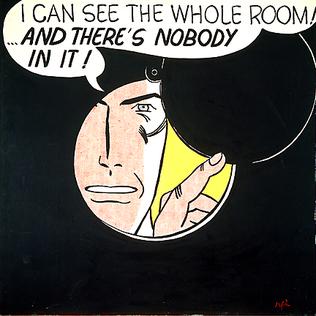
I Can See the Whole Room...and There's Nobody in It! is a 1961 painting by Roy Lichtenstein. It is a painting of a man looking through a peephole. It formerly held the record for highest auction price for a Lichtenstein painting.

In the Car is a 1963 pop art painting by Roy Lichtenstein. The smaller, older of the two versions of this painting formerly held the record for highest auction price for a Lichtenstein painting. The larger version has been in the collection of the Scottish National Gallery of Modern Art in Edinburgh since 1980.

Crying Girl is the name of two different works by Roy Lichtenstein: a 1963 offset lithograph on lightweight, off-white wove paper and a 1964 porcelain enamel on steel.

Hopeless is a 1963 painting with oil paint and acrylic paint on canvas by Roy Lichtenstein. The painting is in the collection of the Kunstmuseum Basel.
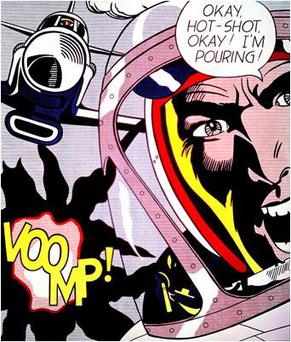
Okay Hot-Shot, Okay! is a 1963 pop art painting by Roy Lichtenstein that uses his Ben-Day dots style and a text balloon. It is one of several examples of military art that Lichtenstein created between 1962 and 1964, including several with aeronautical themes like this one. It was inspired by panels from four different comic books that provide the sources for the plane, the pilot, the text balloon and the graphic onomatopoeia, "VOOMP!".

Bratatat! is a 1963 pop art painting by Roy Lichtenstein in his comic book style of using Ben-Day dots and a text balloon.

Brattata is a 1962 pop art painting by Roy Lichtenstein in his comic book style of using Ben-Day dots and a text balloon. The work is held in the collection at the Tehran Museum of Contemporary Art. It is one of several Lichtenstein works from All-American Men of War issue #89, but is a reworking of its source panel.

Jet Pilot is a 1962 pop art work done in graphite pencil by Roy Lichtenstein. Like many of Lichtenstein's works from this time period, it was inspired by a comic book image, but he made notable modifications of the source in his work.

Crak! is a 1963 pop art lithograph by Roy Lichtenstein in his comic book style of using Ben-Day dots and a text balloon. It was used in marketing materials for one of Lichtenstein's early shows. It is one of several of his works related to military art and monocular vision.
